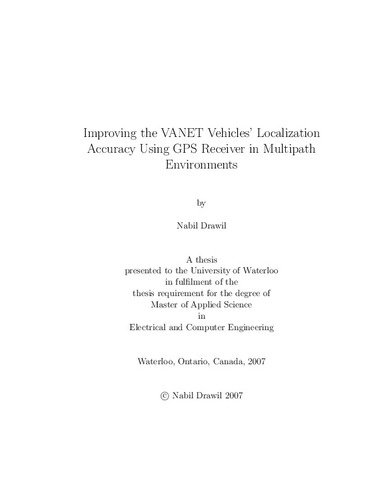| dc.contributor.author | Drawil, Nabil | |
| dc.date.accessioned | 2007-09-27 17:31:25 (GMT) | |
| dc.date.available | 2007-09-27 17:31:25 (GMT) | |
| dc.date.issued | 2007-09-27T17:31:25Z | |
| dc.date.submitted | 2007-09-25 | |
| dc.identifier.uri | http://hdl.handle.net/10012/3349 | |
| dc.description.abstract | The Vehicular Ad-hoc Network (VANET) has been studied in many fields since it
has the ability to provide a variety of services, such as detecting oncoming collisions
and providing warning signals to alert the driver. The services provided by
VANET are often based on collaboration among vehicles that are equipped with
relatively simple motion sensors and GPS units. Awareness of its precise location
is vital to every vehicle in VANET so that it can provide accurate data to its
peers. Currently, typical localization techniques integrate GPS receiver data and
measurements of the vehicle’s motion. However, when the vehicle passes through
an environment that creates a multipath effect, these techniques fail to produce the
high localization accuracy that they attain in open environments. Unfortunately,
vehicles often travel in environments that cause a multipath effect, such as areas
with high buildings, trees, or tunnels. The goal of this research is to minimize the
multipath effect with respect to the localization accuracy of vehicles in VANET.
The proposed technique first detects whether there is a noise in the vehicle location
estimate that is caused by the multipath effect using neural network technique. It
next takes advantage of the communications among the VANET vehicles in order
to obtain more information from the vehicle’s neighbours, such as distances from
target vehicle and their location estimates. The proposed technique integrates all
these pieces of information with the vehicle’s own data and applies optimization
techniques in order to minimize the location estimate error.
The new techniques presented in this thesis decrease the error in the location estimate
by 53% in the best cases, and in the worst case produce almost the same
error in the location estimate as the traditional technique. Moreover, the simulation
results show that 60% of the vehicles in VANET decrease the error in their
location estimates by more than 13.8%. | en |
| dc.language.iso | en | en |
| dc.publisher | University of Waterloo | en |
| dc.subject | Localization | en |
| dc.subject | Location estimate | en |
| dc.subject | Accuracy | en |
| dc.subject | VANET | en |
| dc.subject | Ad hoc networks | en |
| dc.subject | Mobile networks | en |
| dc.subject | Wireless communications | en |
| dc.subject | Optimization | en |
| dc.subject | Kalman Filter | en |
| dc.subject | GPS | en |
| dc.title | Improving the VANET Vehicles' Localizatoin Accuracy using GPS Receiver in Multipath Environments | en |
| dc.type | Master Thesis | en |
| dc.pending | false | en |
| dc.subject.program | Electrical and Computer Engineering | en |
| uws-etd.degree.department | Electrical and Computer Engineering | en |
| uws-etd.degree | Master of Applied Science | en |
| uws.typeOfResource | Text | en |
| uws.peerReviewStatus | Unreviewed | en |
| uws.scholarLevel | Graduate | en |

